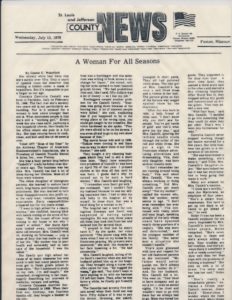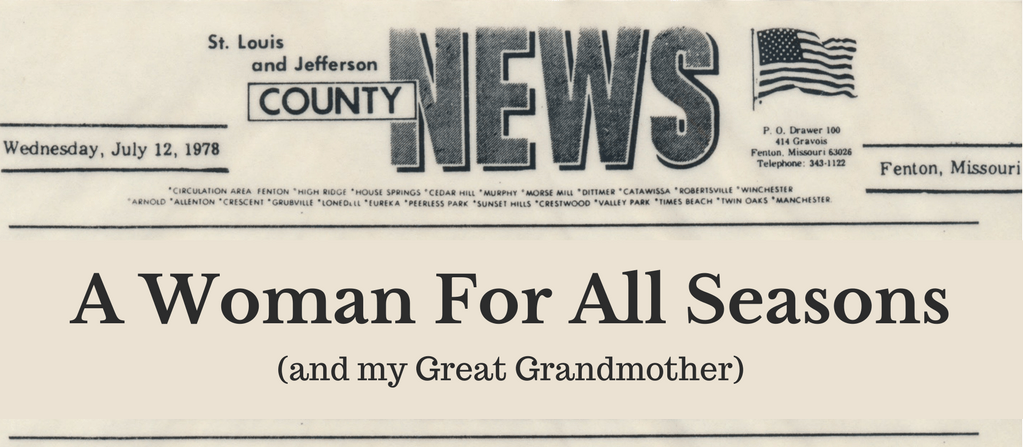A Woman For All Seasons
Originally Published Wednesday, July 12, 1978
St Louis and Jefferson County News, by Connie E. Wakefield
Her silvery white hair hints that she’s surely over fifty. Only a touch of lipstick clues the observer that nothing is hidden under a mask of beautifiers. But it’s impossible to put a finger on her age.
Concetta Caminita Castelli was born in Partinico, Italy on February 25, 1906. The fact that she’s seventy two years old is not particularly astounding. Nor is it unusual for a woman to look years younger than she is. What astonishes people is that she’s still a “working girl.” Every weekday she rises early, performs a few household chores, then heads for the office where she puts in a full day. She then returned home to cook, clean, and knit until the 10:00 new is over.
Voted 1977 “Boss of the Year” by the Archway Chapter of American Businesswomen’s Association, she is the President of Castelli Tuxedo Rental and Sales, Inc. near Fenton.
She was a busy person long before “Castelli’s” made its debut over thirty years ago. Mrs. Castelli has had a lot of ideas during her lifetime. Most all of them were winners.
The oldest daughter of immigrant parents, she learned to endure hard work, long hours and frequent disappointments. She also learned to turn those disappointments into profit or at the very least, valuable learning experiences. Early responsibilities prepared her for the years ahead.
“I went to high school for a couple months,” she confided, leaning back with hands resting on the arms of her chair, “But the truant officer kept coming to my house to see why I wasn’t at school.” Her sharp dark eyes looked away, contemplating some old emotion. Mrs. Castelli went on, showing no bitterness – only a sense of duty that has made up most of her life. “My mother was in poor health and somebody had to take care of the household. I was the oldest.”
She finally quit high school because of so many absences, but was quick to add that many people never even to to finish grade school in those days. “But I continued to study on my own. I’m self-taught,” she remarked, straightening in her chair, eagerly describing her interests in medicine, recipes and sewing.
Concetta Cominita married Bartolomeo Castelli in 1925. When their first son, Anthony, was fourteen months old, they bought a theater in the city.
“I learned everything about the business,” said Mrs. Castelli, eyebrows arched above her glasses. “I even had to book shows and make popcorn.”
 A neighborhood man, impressed with her efficiency, asked the young woman to book films for his theater. The part time job paid fifty dollars a week. She wrinkled her forehead remarking “what was a lot of money in those days.” She accepted that job while continuing to work with her husband in their own business.
A neighborhood man, impressed with her efficiency, asked the young woman to book films for his theater. The part time job paid fifty dollars a week. She wrinkled her forehead remarking “what was a lot of money in those days.” She accepted that job while continuing to work with her husband in their own business.
“A salesman who dealt in movie equipment started coming around the other man’s theater,” said Mrs. Castelli. “I found out then that my boss was a bootlegger and this salesman was willing to book shows in exchange for liquor,” she stated, rolling her eyes upward to meet lowered grayish brows. “We had prohibition then and, like I said, fifty dollars was a lot of money – so I lost my job.”
Bootleggers caused another problem for the Castelli family. “Business was going down because of the bootleg war. A lot of innocent people were killed,” she said, explaining that if you happened to be in the wrong place at the wrong time, you could get caught in the crossfire. Her voice hardened as she spoke. “People were afraid to be on the streets. I was even afraid to go to my own show because of that.”
The movie house was sold in 1929. “Talkies were coming in and there was no way to show them in our little theater,” she said.
They bought a dry cleaning business which they had to sell a short time later. “Santi (now executive vice president of Castelli’s) was born on April 7th of that year. I pressed clothes at the shop all day until he was born. I guess that’s why he turned out to be such a hard worked,” Mrs. Castelli said, laughing.
“I remember once Santi got sick,” she continued, “and I couldn’t find my husband because he was out selling insurance then. I had to take my sick baby to the hospital all by myself. In those days, that was a hard thing for a woman to do.”
The hospital had a ward for contagious diseases and Santi was suspected of having spinal meningitis. He was only three years old when they him from her and isolated him for several days.
“I prayed to God that he didn’t have it.” As she spoke, her voice quivered. “The phone rang with the news and when I was on my knees in my front room praying. My prayers were answered,” she said, the muscles in her face loosening a bit. “He had pneumonia.”
Mrs. Castelli laughed, telling of little Santi’s reaction when she and her husband picked him up at the hospital. They brought along a nurse who often cared for him. “He hugged the nurse,” she said, “but didn’t want to have anything to do with me because I’d left him there. Then, after he was home a while, he finally got friendly again.”
The Castellis had seventy five dollars saved when their third son was born. Fifty dollars of it was to pay the doctor. Grinning, she asked, “Can you imagine only paying fifty dollars to have a baby? It was a lot at the time, but not as much as it costs now. Of course, we had our babies at home back then.” Her smile faded as she went on. “It was in October of 1931, just a couple of days after Bart was born. Ours was the first bank in St. Louis to close down because of the depression.” Every cent they saved was swallowed up.
Mr Castelli worked long hours to feed his family. Mrs. Castelli made all their clothes, “I made knickers for the boys,” she said, smiling as I noticed the family photograph near her desk. It was taken around 1937. All four boys wore starched white outfits; the two oldest in pants cut to the knee with long white socks and the youngest in short pants. They all had polished white shoes. The tiny girl on Mrs. Castelli’s lap wore a well fitted dress and a ribbon in her hair. The picture gives no hint of the furious war waged against them by the depression.
“After Joe was born in 1935,a lady friend of mine said, ‘I don’t know why you don’t sew for people. You’ve got hands of gold’ and that’s what gave me the idea,” said Mrs. Castelli, ignoring the telltale needle stuck through the collar of her red and white dress. She put a sign in the front room window advertising alterations and dressmaking. Vita, their only daughter, was born several months later.
“I don’t remember her not running around being busy,” Vita said about Mrs. Castelli. “She was always working or doing something.” Did Mrs. Castelli ever get much sleep? “Not my mother!” replied the woman who, like her mother, never seems to age. “I don’t even remember her ever being sick.” Vita continued with ready smile and easy laugh, speaking proudly of the lady whose years have spanned nearly three quarters of a century. “She was stern and determined,” said the youngest member of the family. “She never met a situation she couldn’t handle.”
Vita’s eyes glistened with love and respect for her old fashioned parents as she continued. “My father would never punish me. He’d always make my mother do it.” And, for her husband, Mrs. Castelli did a lot. Vita went on. “Dad liked to have company and go out a lot – even on school nights. I’d be tired and wouldn’t want to go with them, but we always had to go. Mom was bored but she would just sit there and talk to another woman while Dad played cards. I don’t know how she did it after working all day and taking care of the family.”
Mrs. Castelli took in sewing at home for eight years. Her clientele grew. She and her husband bought a two family flat, leasing out the upstairs portion, and rented a shop across the street. The business grew to include handmade bridal gowns and an assortment of dry goods. They expanded to the shop next door. A short time later, they opened a third store next to the others and started a dry cleaning business. After World War II, they stopped selling dry goods and concentrated on bridal gowns. Then they added a new line.
“With four boys,” said Mrs. Castelli, “I decided to go into something that they could do when they got older. That’s why I went into formal wear for men.”
Concetta Castelli never stopped working though her health wavered for a few years. Her little business has grown to a corporation of ten stores.
“She was determined to make something; she’s done it,” said Tillie, Mrs Castelli’s daughter-in-law. “Her sons helped her, but it was her determination to keep going that made it work.”
Many are amazed by Mrs. Castelli’s stamina.
“I think she’s terrific,” says Joe Martorana, an employee of four years. “She’s a smart businesswoman. You have to get up two days in advance to get ahead of her,” he said.
Helen Bryan has been a Castelli employee for six years. Impressed by Mrs. Castelli’s concern for other people, Helen remarked, “She’s never too busy to listen and she’s always willing to help. Your troubles are her troubles. And she’s always there if somebody is sick or needs something.” How wells does her boss cope with the problems of running a business? “She puts up with a lot of strain. I’ve never seen her lose her cool,” Helen said.
“She’s really a remarkable person,” exclaims a fifteen year Castelli veteran, Jessie Boyd. Sometimes I wonder where she finds her strength. Many things have happened over the years, but she’s always able to adjust and she helps others adjust to, “she added.
Have the years changed Mrs. Castelli? “She hasn’t slowed down a bit,” says Jessie. “The years haven’t made any difference.”
Unlike our changeable seasons, Mrs. Castelli remains steadfast. At seventy two, she’s still going strong and making plans for the future.



